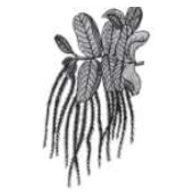Asexaul reproduction by pear shaped biflagellate zoospores is seen in most:
(1) Green algae
(2) Brown algae
(3) Red algae
(4) Both (2) and (3)
All the following pteriodophytes belong to the Class Pteropsida except:
(1) Dryopteris
(2) Pteris
(3) Selaginella
(4) Adiantum
Sexual reproduction by non-flagellated but similar in size gametes is seen in:
1. Chlamydomanas
2. Volvox
3. Spirogyra
4. Fuccus
In mosses, the sex organs are seen in:
1. Protonema stage
2. Leafy stage
3. Capsule of the sporophyte
4. Seta of the sporophyte
The features seen in the gymnosperm Cycas include:
I. Coralloid roots
II. Unbranched stems
III. Pinnate persistent leaves
IV. Male cones and megasporophyllys borne on same plant
1. I and II only
2. I and IV only
3. I, II and III only
4. I, II, III, and IV
Both bryophytes and pteridophytes:
(1) are vascular cryptogams
(2) have a dominant sporophyte
(3) reproduce only sexually
(4) are haplo-diplontic
The life cycle pattern shown in the given diagram is not see in:

1. Chlamydomanas
2. Spirogyra
3. Volvox
4. Ectocarpus
The given diagram shows:

1. An alga that lacks flagellated cells
2. A liverwort
3. A heterosporous pteridophyte
4. A gymnosperm with non motile sperms
Identify the statement that most accurately describes the plant shown in the given figure:

1. This the male prothallus of Marchanita; A is antheridiophore and B is Gemma cup
2. This the female prothallus of Marchanita; A is archegoniophore and B is Gemma cup
3. This the male prothallus of Sphagnum; A is antheridiophore and B is Gemma cup
4. This the female prothallus of Sphagnum; A is archegoniophore and B is Gemma cup
The diploid sporphyte is represented by a dominant, independent, photoshynthetic, vascular plant body. It alternates with multicellular, saprophytic/autotrophic, independent but short-lived haploid gametophyte. This type of pattern is exhibited by
1. Bryophytes (Sphagnum, Polytrichum).
2.Pteridophytes (Selaginella, Lycopodium).
3. Most of the algal genera (Fucus, Chara, Polysiphonia).
4. Seed plants (gymnosperms and antiosperms).






